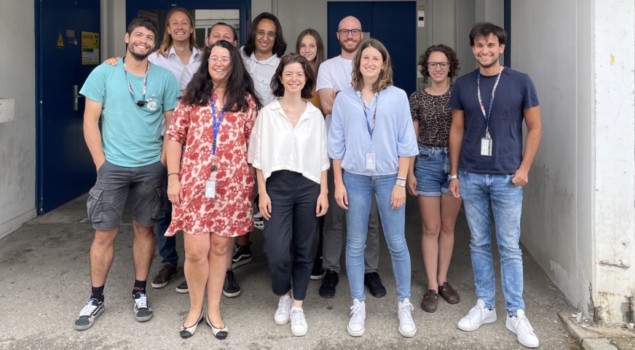
A research team headed up at CERN has won the Roberts Prize for the best paper published in Physics in Medicine & Biology during the last year. The award-winning paper, Advances in heterostructured scintillators: toward a new generation of detectors for TOF-PET, describes how heterostructured scintillators could be used to improve the coincidence time resolution (CTR) of time-of-flight (TOF) PET detectors.
PET is a medical imaging technique commonly used for diagnosis of cancers and neurodegenerative disease, and the CTR is a key parameter influencing the performance of TOF-PET scanners. Achieving a value below 100 ps would provide major clinical benefits, such as improved image quality, shorter acquisition times or reduced radioactive dose.
With no detectors previously available that could achieve a CTR of 100 ps or less, while maintaining good sensitivity and energy resolution, Fiammetta Pagano and co-authors investigated whether heterostructures – which combine two materials with complementary properties – could meet this challenge.
The researchers found that heterostructures formed from alternating layers of high-density bismuth germanate (BGO) and the fast plastic scintillator EJ232 show potential for improving CTR while maintaining reasonable sensitivity compared with standard bulk crystals.
Since the paper was published, the researchers have continued to progress their work in this field. This has included developing a better understanding of the scintillation properties of the heterostructures, as well as improving the time capabilities of BGO and EJ232 heterostructures using different readout approaches. The team is also testing several fast nanoscintillators that could replace EJ232 to further enhance performance.
“One of the advances is the use of double-sided readout applied to heterostructures – where the pixel is read out by a silicon photomultiplier from both of its extremities – to improve the CTR,” Pagano explains. “These results will be presented in the next IEEE Nuclear Science Symposium and Medical Imaging Conference and we hope to publish them soon.”
The researchers have also recently constructed a heterostructure-based TOF-PET module, which they envisage will soon be ready for testing.

Heterostructured scintillators improve timing resolution of PET detectors
Pagano notes that while the concept of heterostructures had been introduced previously, it remains a relatively new area and the TOF-PET community is becoming more and more interested in this approach. “In our paper we showed the CTR improvement achievable with BGO and EJ232 heterostructures compared to BGO, but we also pointed out the main limitations together with some suggestions about how to overcome them,” she explains.
Pagano tells Physics World that she was really surprised by the news that her paper had won the Roberts Prize. “I am only at the beginning of my career as a researcher and I am honoured that one of the main studies I conducted during my PhD has been awarded,” she says.
- SEO Powered Content & PR Distribution. Get Amplified Today.
- PlatoData.Network Vertical Generative Ai. Empower Yourself. Access Here.
- PlatoAiStream. Web3 Intelligence. Knowledge Amplified. Access Here.
- PlatoESG. Carbon, CleanTech, Energy, Environment, Solar, Waste Management. Access Here.
- PlatoHealth. Biotech and Clinical Trials Intelligence. Access Here.
- Source: https://physicsworld.com/a/scintillator-study-awarded-physics-in-medicine-biology-best-paper-prize/
- :has
- :is
- :where
- $UP
- 100
- 7
- a
- About
- Achieve
- achieving
- acquisition
- advances
- also
- am
- and
- applied
- approach
- approaches
- AREA
- AS
- At
- available
- award-winning
- awarded
- BE
- becoming
- been
- Beginning
- below
- benefits
- BEST
- Better
- biology
- both
- but
- by
- capabilities
- Career
- centre
- challenge
- Clinical
- coincidence
- colleagues
- combine
- commonly
- community
- compared
- complementary
- concept
- conducted
- Conference
- continued
- could
- developing
- different
- Disease
- during
- energy
- enhance
- Explains
- FAST
- field
- For
- formed
- found
- from
- front
- further
- generation
- good
- had
- Have
- headed
- her
- hope
- How
- How To
- HTTPS
- i
- IEEE
- image
- Imaging
- improve
- improved
- improvement
- improving
- in
- included
- influencing
- information
- interested
- introduced
- issue
- IT
- ITS
- jpg
- Key
- Last
- Last Year
- layers
- less
- limitations
- Main
- Maintaining
- major
- materials
- max-width
- measuring
- medical
- medicine
- Meet
- Module
- more
- my
- New
- news
- next
- no
- Notes
- nuclear
- of
- ONE
- only
- or
- our
- out
- Overcome
- Paper
- parameter
- performance
- phd
- Physics
- Physics World
- Pixel
- plastic
- plato
- Plato Data Intelligence
- PlatoData
- potential
- presented
- previously
- prize
- Progress
- properties
- provide
- publish
- published
- quality
- Read
- ready
- really
- reasonable
- recently
- Reduced
- relatively
- remains
- replace
- research
- researcher
- researchers
- Resolution
- Results
- ROW
- says
- Science
- Sensitivity
- several
- she
- show
- showed
- Silicon
- some
- soon
- standard
- studies
- Study
- such
- surprised
- Symposium
- team
- tells
- Testing
- that
- The
- their
- Them
- they
- this
- thumbnail
- time
- times
- timing
- to
- together
- toward
- true
- understanding
- use
- used
- using
- value
- was
- we
- WELL
- whether
- which
- while
- will
- with
- Won
- Work
- world
- would
- year
- zephyrnet













